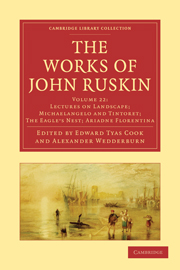Book contents
- Frontmatter
- Contents
- LIST OF ILLUSTRATIONS
- INTRODUCTION TO THIS VOLUME
- I “LECTURES ON LANDSCAPE” (1871)
- II “THE RELATION BETWEEN MICHAEL ANGELO AND TINTORET” (1871)
- III “THE EAGLE'S NEST”: TEN LECTURES ON THE RELATION OF NATURAL SCIENCE TO ART (1872)
- IV “ARIADNE FLORENTINA”: SIX LECTURES ON WOOD AND METAL ENGRAVING (1872)
- APPENDIX: NOTES FOR OXFORD LECTURES
- Plate section
I - “LECTURES ON LANDSCAPE” (1871)
Published online by Cambridge University Press: 07 September 2011
- Frontmatter
- Contents
- LIST OF ILLUSTRATIONS
- INTRODUCTION TO THIS VOLUME
- I “LECTURES ON LANDSCAPE” (1871)
- II “THE RELATION BETWEEN MICHAEL ANGELO AND TINTORET” (1871)
- III “THE EAGLE'S NEST”: TEN LECTURES ON THE RELATION OF NATURAL SCIENCE TO ART (1872)
- IV “ARIADNE FLORENTINA”: SIX LECTURES ON WOOD AND METAL ENGRAVING (1872)
- APPENDIX: NOTES FOR OXFORD LECTURES
- Plate section
Summary
In my inaugural lecture, I stated that while holding this professorship I should direct you, in your practical exercises, chiefly to natural history and landscape. And having in the course of the past year laid the foundational elements of art sufficiently before you, I will invite you, now, to enter on real work with me; and accordingly I propose during this and the following term to give you what practical leading I can in elementary study of landscape, and of a branch of natural history which will form a kind of centre for all the rest—Ichthyology.
In the outset I must shortly state to you the position which landscape painting and animal painting hold towards the higher branches of art.
2. Landscape painting is the thoughtful and passionate representation of the physical conditions appointed for human existence. It imitates the aspects, and records the phenomena, of the visible things which are dangerous or beneficial to men; and displays the human methods of dealing with these, and of enjoying them or suffering from them, which are either exemplary or deserving of sympathetic contemplation. Animal painting investigates the laws of greater and less nobility of character in organic form, as comparative anatomy examines those of greater and less development in organic structure; and the function of animal painting is to bring into notice the minor and unthought-of conditions of power or beauty, as that of physiology is to ascertain the minor conditions of adaptation.
- Type
- Chapter
- Information
- The Works of John Ruskin , pp. 1 - 70Publisher: Cambridge University PressPrint publication year: 2010First published in: 1906



